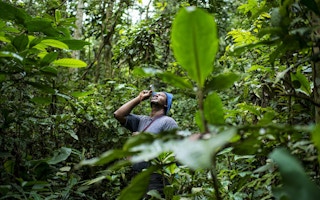In the birthplace of Arabica coffee — Ethiopia’s Kafa Biosphere Reserve — rangers are using Facebook to monitor and verify changes in their forests.
In a joint study with the German nongovernmental organization Nature and Biodiversity Conservation Union (NABU) and scientists from Wageningen University, in collaboration with the Center for International Forestry Research (CIFOR), use remote sensing satellite data to observe the area from space in near real time. If they detect a change, they immediately notify the 30 rangers on the ground via a private Facebook group.
“From space we just see something is happening — but we don’t really know what, or why,” said Martin Herold, a professor at Wageningen University and a CIFOR associate.
“But the rangers can go and say, firstly, if there is a change or not, and secondly, what’s the driver, what’s behind it. And that’s information you cannot see from space,” he said.
“It works interactively, it works in near real time, and so you get a complementary data stream going.”
If the rangers notice a change on the ground, they use the Facebook group to alert the scientists and their fellow rangers, who can focus their attention and monitoring on that area.
“Internet just arrived recently in the area, and at this point in time, it’s Facebook that everyone uses on a regular basis rather than email, and it’s just easier to keep people engaged. That just reflects the local reality,” Herold said.
“It may be something else in the future, but that’s what works now.”
Scaling up
Niki Mardas from the Global Canopy Programme (GCP), a tropical forest think tank, says new technologies like these have an important role to play in involving local communities in REDD+ (Reducing Emissions from Deforestation and forest Degradation) — the U.N.-backed scheme that would see developing countries compensated for reducing emissions from deforestation and forest degradation. For the scheme to work, changes in forest carbon stocks need to be monitored, reported and verified.
“Communities are obviously the best placed to gather that data, and their participation in the REDD process is absolutely essential for the success of REDD+ and for equity in the process. It’s crucial that communities are involved in this large-scale process that’s going on that sometimes excludes them,” he said, adding that digital technology is making it easier.
Mobile phones, for example, are getting cheaper, more robust, and have longer battery lives — and are becoming widely used in many communities.
“A mobile phone is a gathering device you can enter data into, and then share via the Internet — but it also has a camera and a GPS (Global Positioning System). It’s a very versatile, rapid medium. If you gather paper-based data it may be weeks, months — or never — before the data gets shared, but with these new technologies there’s a much quicker turnaround,” Mardas said.
“It also engages different groups in the community, so younger people that are more familiar with the technology can train older members of the community.”
The data they collect can be what Mardas calls “the bread and butter of REDD+” — assessing changes in the forest cover and the amount of carbon stored there, as the Ethiopian rangers do.
“But also there’s versatility there to gather survey data on well-being and safeguards, things that you can’t see from the sky,” he said.
“They can gather data to help them manage their own forests, data which might be useful to them on ecosystem services, fish stocks, or sacred places.”
While concerns are often raised about the accuracy of community-gathered data, Mardas says there is evidence showing this kind of data is just as reliable as that gathered by local or national experts.
The challenge now is scaling up these efforts so that data gathered by communities can be integrated into regional, national and global REDD+ programs.
“We’ve observed in the projects that we’ve been working on that there’s a very strong internal effort within a community to standardize, improve the tools, get the best approaches — but there’s been very little sharing of information on protocols between different groups,” Mardas said.
“And unless you have a standard and straightforward approach, then it’s very hard to get that data and information useable by outside systems, and to integrate it with regional or national data.”
Linking local to national
A new paper recently published by Martin Herold and other scientists from CIFOR and Wageningen University addresses this very issue. The paper highlights the importance of local drivers of deforestation and degradation, and thus the relevance of community involvement in REDD+ implementation and monitoring. It also outlines a conceptual framework for linking local and national monitoring.
Community-based monitoring for REDD+ is new, Herold says, so national and local interests need to find win-win opportunities to get an integrated monitoring system started. As yet, no country is comprehensively implementing this kind of scheme but several are in development.
To assist in this process, Mardas said the GCP will set up an online knowledge-sharing platform — linked to the GCP’s existing site The REDD Desk — that would provide a space for communities, practitioners and policy-makers to learn from each other, and help to mainstream this kind of monitoring.
“Community monitoring has a long heritage of unquestionable value, and our question coming into this is how do we take that heritage and make it usable by policy makers and by the international processes,” he said.










